seats KIA Rio 2014 3.G Owner's Manual
[x] Cancel search | Manufacturer: KIA, Model Year: 2014, Model line: Rio, Model: KIA Rio 2014 3.GPages: 397, PDF Size: 7.56 MB
Page 14 of 397

Safety features of your vehicle
23
Driver’s seat
(1) Forward and rearward
(2) Seatback angle
(3) Seat cushion height
(4) Seat warmer
(5) Headrest
Front passenger’s seat
(6) Forward and rearward
(7) Seatback angle
(8) Seat warmer
(9) Headrest
Rear seat
(10) Headrest
(11) Seatback folding
SEAT
OUB032001K
■5 door■4 door
❈ The actual seats in the vehicle may differ from the illustration.
Page 15 of 397

33
Safety features of your vehicle
WARNING- Driver’s seat Never attempt to adjust the seatwhile the vehicle is moving. This
could result in loss of control of
your vehicle.
Do not allow anything to interfere with the normal position of the
seatback. Storing items against a
seatback or in any other way
interfering with proper locking of
a seatback.
Sit as far back as possible from the steering wheel while still
maintaining comfortable control
of your vehicle. A distance of at
least 10" from your chest to the
steering wheel is recommended.
Failure to do so can result in
airbag inflation injuries to the
driver.
WARNING - Uprighting
seat
Do not press the release lever on a
manual seatback without holding
and controlling the seatback. The
seatback will spring upright possi-
bly impacting you or other passen-
gers.
WARNING- Loose objects
Do not place anything in the dri-
ver's foot well or under the front
seats. Loose objects in the driver's
foot area could interfere with the
operation of the foot pedals.
WARNING- Driver respon-
sibility for passengers
The driver must advise the passen-
ger to keep the seatback in an
upright position whenever the vehi-
cle is in motion. If a seat is reclined
during an accident, the occupant's
hips may slide under the lap por-
tion of the seat belt, applying great
force to the unprotected abdomen.
WARNING- Seat cushion
Occupants should never sit on seat
cushions. The passenger's hips
may slide under the lap portion of
the seat belt during an accident or
a sudden stop.
WARNING- Seat adjustment
Do not adjust the seat while wear-
ing seat belts. Moving the seat
forward will cause strong pres-
sure on the abdomen.
Do not place your hand near the seat bottom or seat track while
adjusting the seat. Your hand
could get caught in the seat
mechanism.
Page 17 of 397
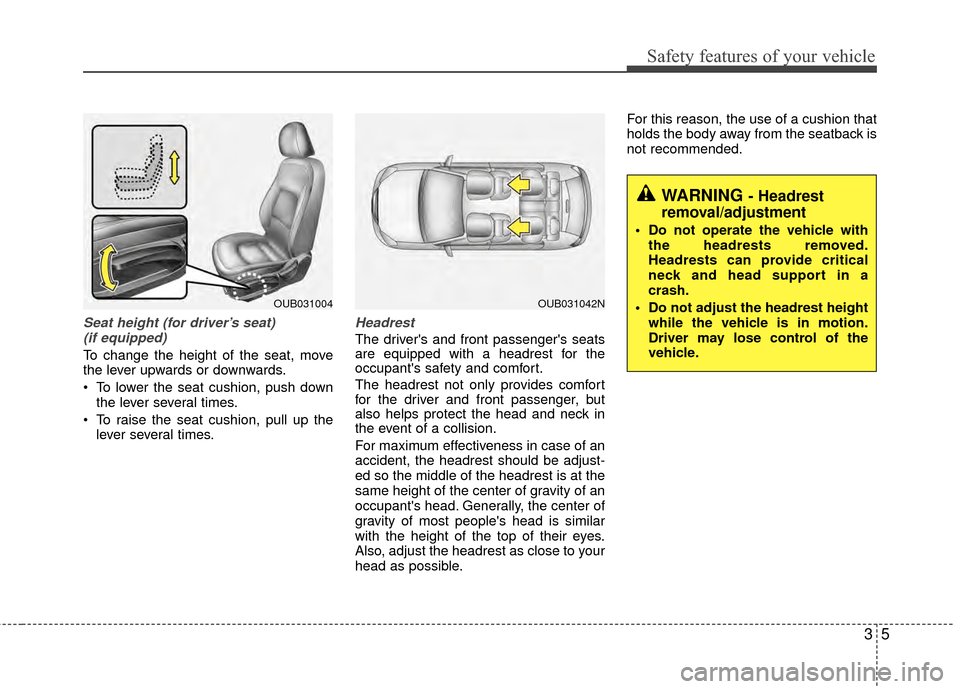
35
Safety features of your vehicle
Seat height (for driver’s seat) (if equipped)
To change the height of the seat, move
the lever upwards or downwards.
• To lower the seat cushion, push down the lever several times.
To raise the seat cushion, pull up the lever several times.
Headrest
The driver's and front passenger's seats
are equipped with a headrest for the
occupant's safety and comfort.
The headrest not only provides comfort
for the driver and front passenger, but
also helps protect the head and neck in
the event of a collision.
For maximum effectiveness in case of an
accident, the headrest should be adjust-
ed so the middle of the headrest is at the
same height of the center of gravity of an
occupant's head. Generally, the center of
gravity of most people's head is similar
with the height of the top of their eyes.
Also, adjust the headrest as close to your
head as possible. For this reason, the use of a cushion that
holds the body away from the seatback is
not recommended.
OUB031004OUB031042N
WARNING - Headrest
removal/adjustment
Do not operate the vehicle with
the headrests removed.
Headrests can provide critical
neck and head support in a
crash.
Do not adjust the headrest height while the vehicle is in motion.
Driver may lose control of the
vehicle.
Page 19 of 397
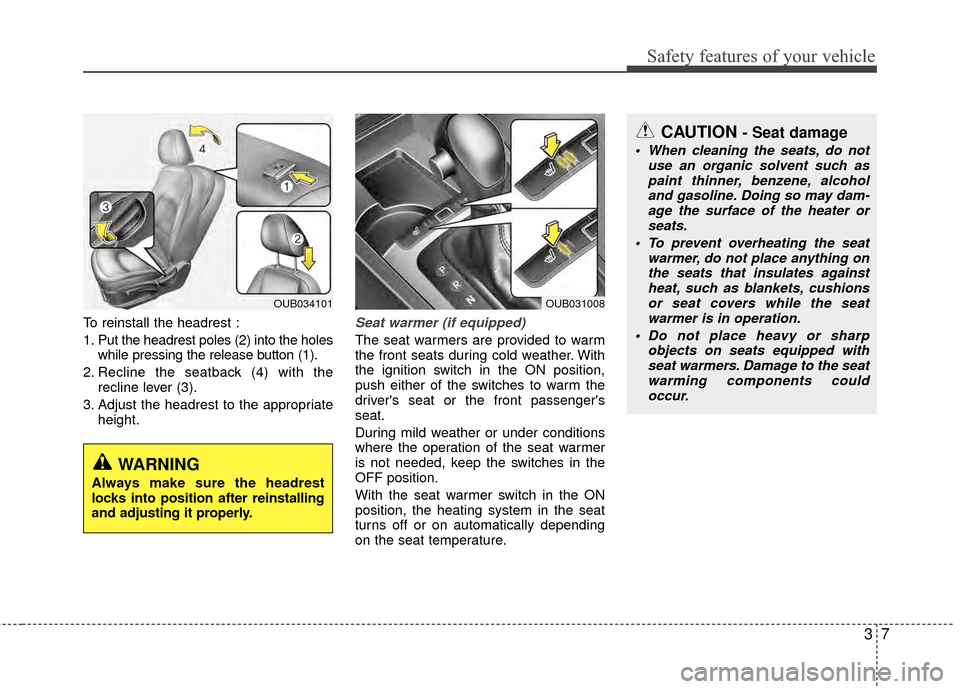
37
Safety features of your vehicle
To reinstall the headrest :
1. Put the headrest poles (2) into the holeswhile pressing the release button (1).
2. Recline the seatback (4) with the recline lever (3).
3. Adjust the headrest to the appropriate height.Seat warmer (if equipped)
The seat warmers are provided to warm
the front seats during cold weather. With
the ignition switch in the ON position,
push either of the switches to warm the
driver's seat or the front passenger's
seat.
During mild weather or under conditions
where the operation of the seat warmer
is not needed, keep the switches in the
OFF position.
With the seat warmer switch in the ON
position, the heating system in the seat
turns off or on automatically depending
on the seat temperature.
OUB031008
CAUTION - Seat damage
When cleaning the seats, do not use an organic solvent such aspaint thinner, benzene, alcohol and gasoline. Doing so may dam-age the surface of the heater orseats.
To prevent overheating the seat warmer, do not place anything onthe seats that insulates against heat, such as blankets, cushionsor seat covers while the seat warmer is in operation.
Do not place heavy or sharp objects on seats equipped withseat warmers. Damage to the seatwarming components couldoccur.
WARNING
Always make sure the headrest
locks into position after reinstalling
and adjusting it properly.
OUB034101
Page 24 of 397
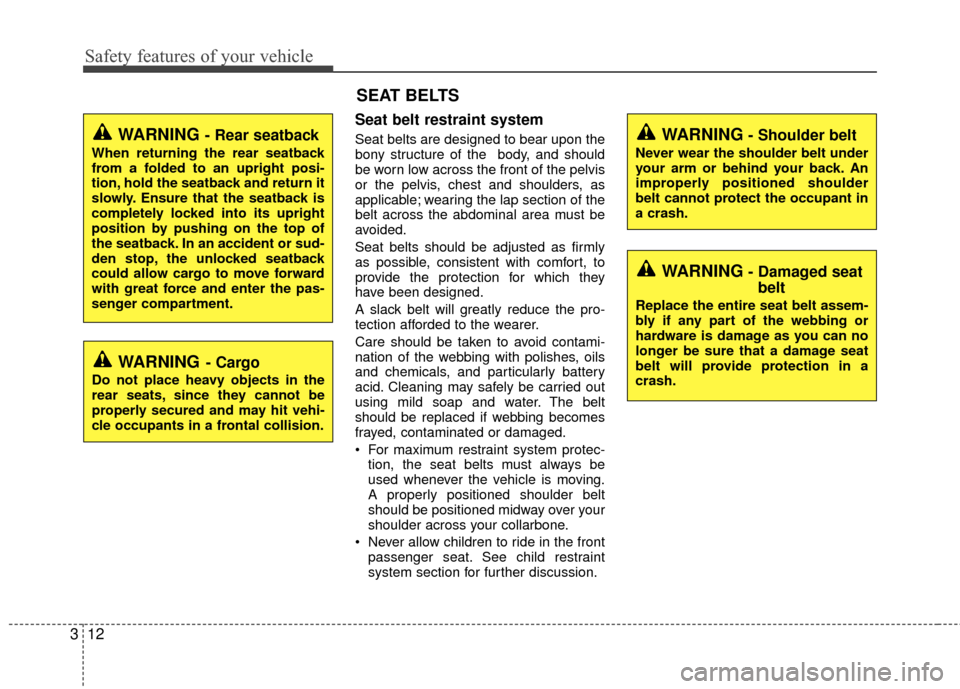
Safety features of your vehicle
12
3
Seat belt restraint system
Seat belts are designed to bear upon the
bony structure of the body, and should
be worn low across the front of the pelvis
or the pelvis, chest and shoulders, as
applicable; wearing the lap section of the
belt across the abdominal area must be
avoided.
Seat belts should be adjusted as firmly
as possible, consistent with comfort, to
provide the protection for which they
have been designed.
A slack belt will greatly reduce the pro-
tection afforded to the wearer.
Care should be taken to avoid contami-
nation of the webbing with polishes, oils
and chemicals, and particularly battery
acid. Cleaning may safely be carried out
using mild soap and water. The belt
should be replaced if webbing becomes
frayed, contaminated or damaged.
For maximum restraint system protec-
tion, the seat belts must always be
used whenever the vehicle is moving.
A properly positioned shoulder belt
should be positioned midway over your
shoulder across your collarbone.
Never allow children to ride in the front passenger seat. See child restraint
system section for further discussion.WARNING- Shoulder belt
Never wear the shoulder belt under
your arm or behind your back. An
improperly positioned shoulder
belt cannot protect the occupant in
a crash.
WARNING- Damaged seatbelt
Replace the entire seat belt assem-
bly if any part of the webbing or
hardware is damage as you can no
longer be sure that a damage seat
belt will provide protection in a
crash.
WARNING - Rear seatback
When returning the rear seatback
from a folded to an upright posi-
tion, hold the seatback and return it
slowly. Ensure that the seatback is
completely locked into its upright
position by pushing on the top of
the seatback. In an accident or sud-
den stop, the unlocked seatback
could allow cargo to move forward
with great force and enter the pas-
senger compartment.
WARNING- Cargo
Do not place heavy objects in the
rear seats, since they cannot be
properly secured and may hit vehi-
cle occupants in a frontal collision.
SEAT BELTS
Page 32 of 397
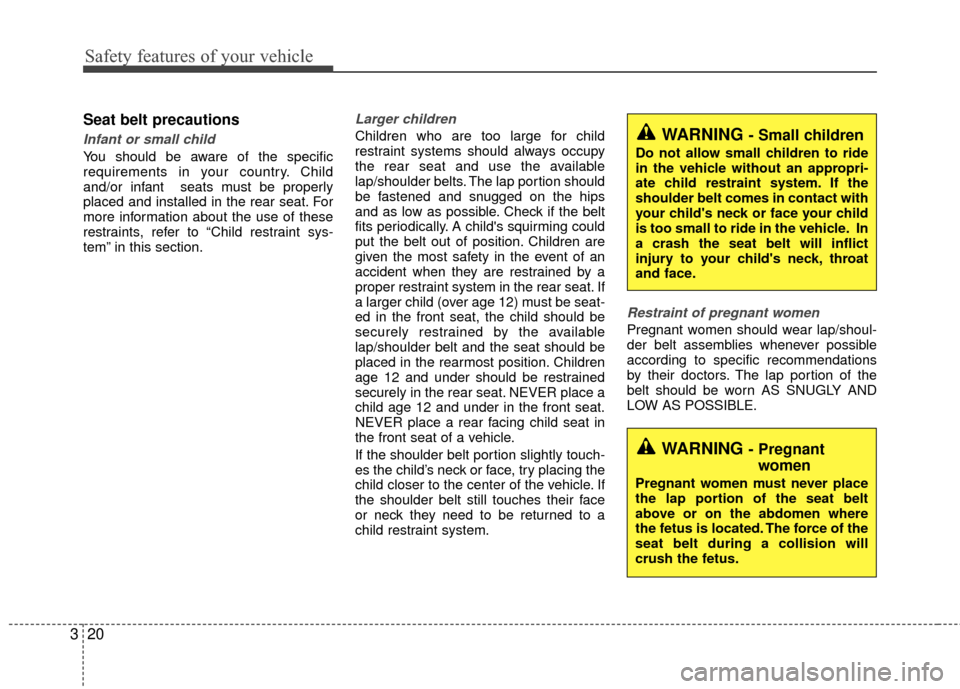
Safety features of your vehicle
20
3
Seat belt precautions
Infant or small child
You should be aware of the specific
requirements in your country. Child
and/or infant seats must be properly
placed and installed in the rear seat. For
more information about the use of these
restraints, refer to “Child restraint sys-
tem” in this section.
Larger children
Children who are too large for child
restraint systems should always occupy
the rear seat and use the available
lap/shoulder belts. The lap portion should
be fastened and snugged on the hips
and as low as possible. Check if the belt
fits periodically. A child's squirming could
put the belt out of position. Children are
given the most safety in the event of an
accident when they are restrained by a
proper restraint system in the rear seat. If
a larger child (over age 12) must be seat-
ed in the front seat, the child should be
securely restrained by the available
lap/shoulder belt and the seat should be
placed in the rearmost position. Children
age 12 and under should be restrained
securely in the rear seat. NEVER place a
child age 12 and under in the front seat.
NEVER place a rear facing child seat in
the front seat of a vehicle.
If the shoulder belt portion slightly touch-
es the child’s neck or face, try placing the
child closer to the center of the vehicle. If
the shoulder belt still touches their face
or neck they need to be returned to a
child restraint system.
Restraint of pregnant women
Pregnant women should wear lap/shoul-
der belt assemblies whenever possible
according to specific recommendations
by their doctors. The lap portion of the
belt should be worn AS SNUGLY AND
LOW AS POSSIBLE.
WARNING - Small children
Do not allow small children to ride
in the vehicle without an appropri-
ate child restraint system. If the
shoulder belt comes in contact with
your child's neck or face your child
is too small to ride in the vehicle. In
a crash the seat belt will inflict
injury to your child's neck, throat
and face.
WARNING - Pregnant
women
Pregnant women must never place
the lap portion of the seat belt
above or on the abdomen where
the fetus is located. The force of the
seat belt during a collision will
crush the fetus.
Page 33 of 397
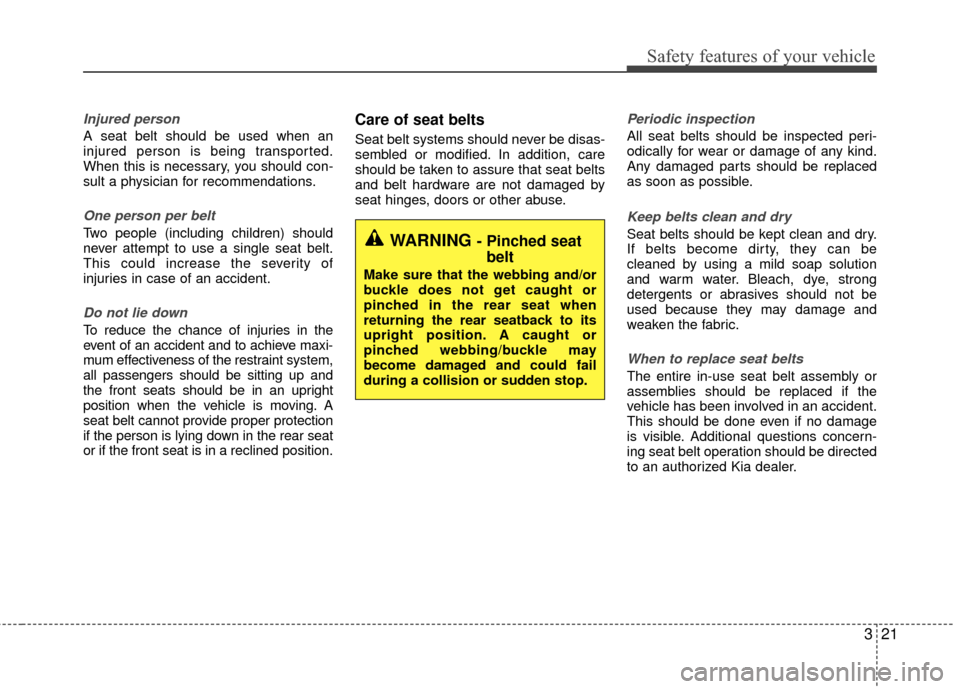
321
Safety features of your vehicle
Injured person
A seat belt should be used when an
injured person is being transported.
When this is necessary, you should con-
sult a physician for recommendations.
One person per belt
Two people (including children) should
never attempt to use a single seat belt.
This could increase the severity of
injuries in case of an accident.
Do not lie down
To reduce the chance of injuries in the
event of an accident and to achieve maxi-
mum effectiveness of the restraint system,
all passengers should be sitting up and
the front seats should be in an upright
position when the vehicle is moving. A
seat belt cannot provide proper protection
if the person is lying down in the rear seat
or if the front seat is in a reclined position.
Care of seat belts
Seat belt systems should never be disas-
sembled or modified. In addition, care
should be taken to assure that seat belts
and belt hardware are not damaged by
seat hinges, doors or other abuse.
Periodic inspection
All seat belts should be inspected peri-
odically for wear or damage of any kind.
Any damaged parts should be replaced
as soon as possible.
Keep belts clean and dry
Seat belts should be kept clean and dry.
If belts become dirty, they can be
cleaned by using a mild soap solution
and warm water. Bleach, dye, strong
detergents or abrasives should not be
used because they may damage and
weaken the fabric.
When to replace seat belts
The entire in-use seat belt assembly or
assemblies should be replaced if the
vehicle has been involved in an accident.
This should be done even if no damage
is visible. Additional questions concern-
ing seat belt operation should be directed
to an authorized Kia dealer.
WARNING - Pinched seat
belt
Make sure that the webbing and/or
buckle does not get caught or
pinched in the rear seat when
returning the rear seatback to its
upright position. A caught or
pinched webbing/buckle may
become damaged and could fail
during a collision or sudden stop.
Page 34 of 397
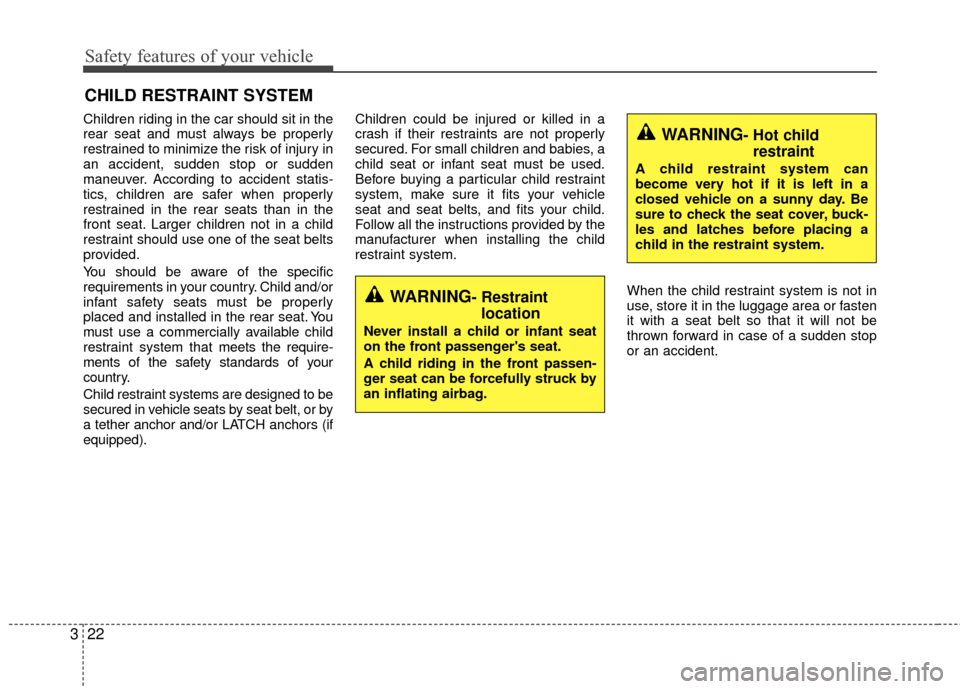
Safety features of your vehicle
22
3
CHILD RESTRAINT SYSTEM
Children riding in the car should sit in the
rear seat and must always be properly
restrained to minimize the risk of injury in
an accident, sudden stop or sudden
maneuver. According to accident statis-
tics, children are safer when properly
restrained in the rear seats than in the
front seat. Larger children not in a child
restraint should use one of the seat belts
provided.
You should be aware of the specific
requirements in your country. Child and/or
infant safety seats must be properly
placed and installed in the rear seat. You
must use a commercially available child
restraint system that m eets the require-
ments of the safety standards of your
country.
Child restraint systems are designed to be
secured in vehicle seats by seat belt, or by
a tether anchor and/or LATCH anchors (if
equipped). Children could be injured or killed in a
crash if their restraints are not properly
secured. For small children and babies, a
child seat or infant seat must be used.
Before buying a particular child restraint
system, make sure it fits your vehicle
seat and seat belts, and fits your child.
Follow all the instructions provided by the
manufacturer when installing the child
restraint system.
When the child restraint system is not in
use, store it in the luggage area or fasten
it with a seat belt so that it will not be
thrown forward in case of a sudden stop
or an accident.
WARNING- Restraint location
Never install a child or infant seat
on the front passenger's seat.
A child riding in the front passen-
ger seat can be forcefully struck by
an inflating airbag.
WARNING- Hot childrestraint
A child restraint system can
become very hot if it is left in a
closed vehicle on a sunny day. Be
sure to check the seat cover, buck-
les and latches before placing a
child in the restraint system.
Page 35 of 397
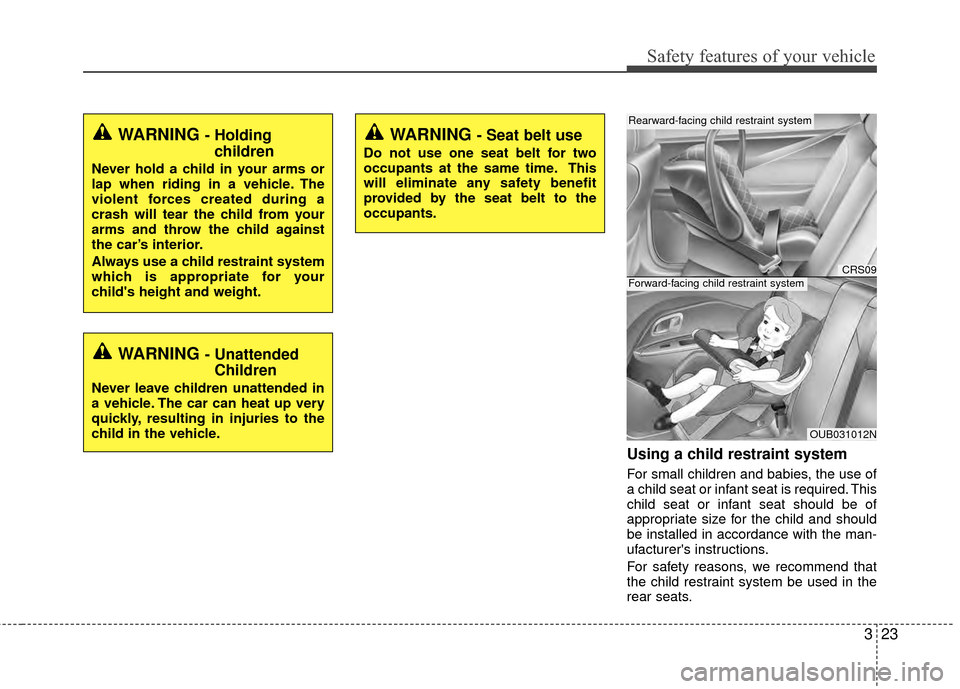
323
Safety features of your vehicle
Using a child restraint system
For small children and babies, the use of
a child seat or infant seat is required. This
child seat or infant seat should be of
appropriate size for the child and should
be installed in accordance with the man-
ufacturer's instructions.
For safety reasons, we recommend that
the child restraint system be used in the
rear seats.
WARNING - Holding children
Never hold a child in your arms or
lap when riding in a vehicle. The
violent forces created during a
crash will tear the child from your
arms and throw the child against
the car’s interior.
Always use a child restraint system
which is appropriate for your
child's height and weight.
WARNING - UnattendedChildren
Never leave children unattended in
a vehicle. The car can heat up very
quickly, resulting in injuries to the
child in the vehicle.
WARNING - Seat belt use
Do not use one seat belt for two
occupants at the same time. This
will eliminate any safety benefit
provided by the seat belt to the
occupants.
CRS09
OUB031012N
Rearward-facing child restraint system
Forward-facing child restraint system
Page 37 of 397

325
Safety features of your vehicle
To install a child restraint system on the
outboard or center rear seats, do the fol-
lowing:
1. Place the child restraint system in theseat and route the lap/shoulder belt
around or through the restraint, follow-
ing the restraint manufacturer’s
instructions. Be sure the seat belt web-
bing is not twisted.
2. Fasten the lap/shoulder belt latch into the buckle. Listen for the distinct “click”
sound.
Position the release button so that it iseasy to access in case of an emergency.
3. Pull the shoulder portion of the seat belt all the way out. When the shoulder
portion of the seat belt is fully extend-
ed, it will shift the retractor to the “Auto
Lock” (child restraint) mode. 4. Slowly allow the shoulder portion of
the seat belt to retract and listen for an
audible “clicking” or “ratcheting” sound.
This indicates that the retractor is in
the “Auto Lock” mode. If no distinct
sound is heard, repeat steps 3 and 4.
OEN036101OEN036102OEN036103